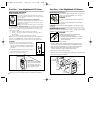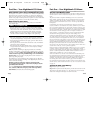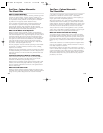
Part Two – Carbon Monoxide -
The Silent Killer
Part Two – Carbon Monoxide -
The Silent Killer
Home Safety Tips
What You Can Do...
•Buy only appliances approved by a nationally recognized
testing laboratory.
•Choose fuel-burning appliances that can be vented to the
outdoors, whenever possible.
•Make sure appliances are installed according to manufacturer’s
instructions and local building codes. Most appliances should
be installed by professionals and should be inspected by the
proper authority after installation.
•Have the heating system, vents, chimney and flue inspected
and cleaned by a qualified technician every year.
•Follow manufacturer’s directions for safe operation of all
fuel-burning appliances.
•Examine vents and chimneys regularly for improper connections,
visible rust or stains.
•Open a window when a fireplace or wood-burning stove is in
use, and provide adequate outdoor air for furnace and water
heater.
•Notice problems that could indicate improper appliance
operation:
– Decreasing hot water supply
– Furnace unable to heat house or runs constantly
– Sooting, especially on appliances
– Unfamiliar or burning odor
– Yellow or orange flame
•Be aware of the symptoms of carbon monoxide poisoning:
– headaches, dizziness, weakness, sleepiness, nausea, vomiting,
confusion and disorientation.
•Recognize that CO poisoning may be the cause when family
members suffer from flu-like symptoms that don’t disappear
but improve when they leave home or extended periods of
time.
•Install a UL 2034 Listed CO alarm for added safety.
– The Consumer Product Safety Commission recommends
that every residence with fuel-burning appliances be
equipped with a UL Listed CO alarm.
What You Should Not Do...
•Never burn charcoal inside a home, garage, cabin, RV or camper.
•Never install, service, or convert fuel-burning appliances from
one type to another without proper knowledge, skills and tools.
•Never use a gas range, oven, or clothes dryer for heating.
•Never operate unvented gas-burning appliances, such as
kerosene or natural gas space heaters, in a closed room.
•Never operate gasoline-powered engines (like vehicles,
motorcycles, lawn mowers, yard equipment or power tools)
in confined areas such as garages or basements, even if an
outside door or window is open.
•Never ignore a safety device when it shuts off an appliance.
•Never ignore a CO alarm.
Be Aware of the Warning Signs of Carbon
Monoxide: Clues You Can See...
•Streaks of carbon or soot around the service door of your
fuel-burning appliances.
•A yellow or orange flame may indicate a problem with natural
gas appliances.
•Excessive rusting on flue pipes or appliance jackets.
•Loose or missing furnace panel.
•Moisture collecting on the windows and walls of furnace rooms.
•Loose or disconnected vent/chimney, fireplace or appliance.
•Small amounts of water leaking from the base of the chimney,
vent or flue pipe.
•Rust on the portion of the vent pipe visible from outside your
home.
•The absence of a draft in your chimney (indicating blockage).
•Fallen soot from the fireplace chimney.
•Loose, damaged or discolored bricks on your chimney.
Clues You Cannot See...
•Internal appliance damage or malfunctioning components
•Improper burner adjustment
•Hidden blockage or damage in chimneys
2-4
2-3
810-1009 AC Digital 11/13/01 11:22 AM Page 24


















